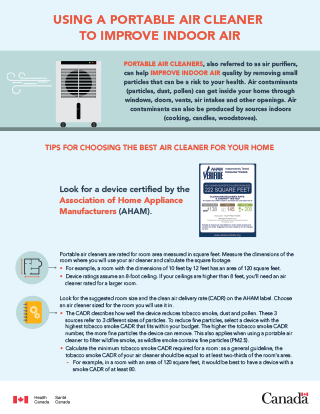Using a portable air cleaner to improve indoor air
Portable air cleaners, also referred to as air purifiers, can help improve indoor air quality by removing small particles that can be a risk to your health. Air contaminants (particles, dust, pollen) can get inside your home through windows, doors, vents, air intakes and other openings. Air contaminants can also be produced by sources indoors (cooking, candles, woodstoves).
On this page
- Tips for choosing the best air cleaner for your home
- Using your portable air cleaner
- When to ventilate your home
Tips for choosing the best air cleaner for your home
- Look for a device certified by the Association of Home Appliance Manufacturers (AHAM).
- Portable air cleaners are rated for room area measured in square feet. Measure the dimensions of the room where you will use your air cleaner and calculate the square footage.
- For example, a room with the dimensions of 10 feet by 12 feet has an area of 120 square feet.
- Device ratings assume an 8-foot ceiling. If your ceilings are higher than 8 feet, you'll need an air cleaner rated for a larger room.
- Look for the suggested room size and the clean air delivery rate (CADR) on the AHAM label. Choose an air cleaner sized for the room you will use it in.
- The CADR describes how well the device reduces tobacco smoke, dust and pollen. These 3 sources refer to 3 different sizes of particles. To reduce fine particles, select a device with the highest tobacco smoke CADR that fits within your budget. The higher the tobacco smoke CADR number, the more fine particles the device can remove. This also applies when using a portable air cleaner to filter wildfire smoke, as wildfire smoke contains fine particles (PM2.5).
- Calculate the minimum tobacco smoke CADR required for a room: as a general guideline, the tobacco smoke CADR of your air cleaner should be equal to at least two-thirds of the room's area.
- For example, in a room with an area of 120 square feet, it would be best to have a device with a smoke CADR of at least 80.
- Portable air cleaners often achieve a high CADR by using a high-efficiency particulate air (HEPA) filter. Both airflow and filter efficiency will impact how well the device works.
- Some devices may also include an activated carbon or other absorbent filter. These may help to remove gases such as volatile organic compounds (VOCs). However, there are no widely used performance rating systems for filters designed to remove gases.
- Avoid devices that produce ozone, as ozone can harm your health. The California Air Regulatory Board (CARB) lists air cleaners that have passed testing for ozone emissions.
- Consider selecting a device with a lower noise rating.
Using your portable air cleaner
To get the most out of your portable air cleaner:
- keep your doors and windows closed
- operate your portable air cleaner in a room where you spend a lot of time
- follow manufacturer instructions for proper placement and use of your portable air cleaner. In general:
- clean or replace the filter as recommended by the manufacturer
- position the air cleaner to avoid blowing directly at or between people in the room
- place your portable air cleaner in a location where air flow won't be blocked by walls, furniture or other objects in the room
- higher fan speeds and longer run times will increase the amount of air that's filtered
When to ventilate your home
While filters in portable air cleaners can help capture some contaminants, the best ways to improve indoor air are to remove the source of the contaminants and to ventilate with clean, outdoor air.
Before opening windows or doors, get up-to-date information about outdoor air quality conditions in your region by checking:
- Air Quality Health Index (AQHI) forecasts
- InfoSmog forecasts for Quebec
- Active weather warnings and air quality advisories
- provincial and territorial governments' websites
For more information on keeping your indoor air clean, visit www.canada.ca/airhealth.
